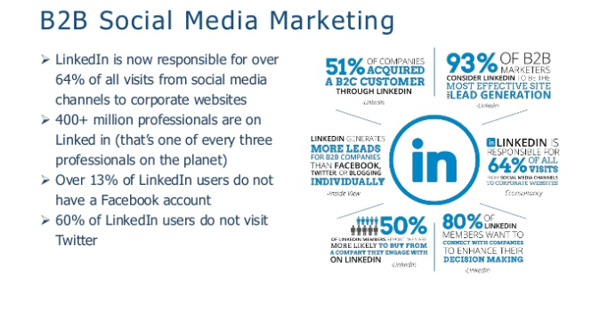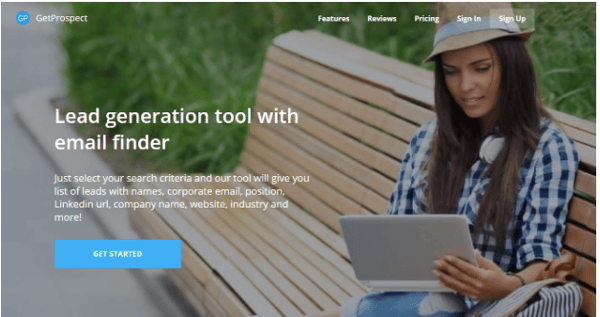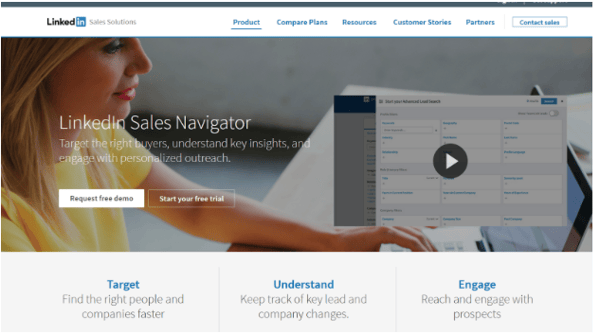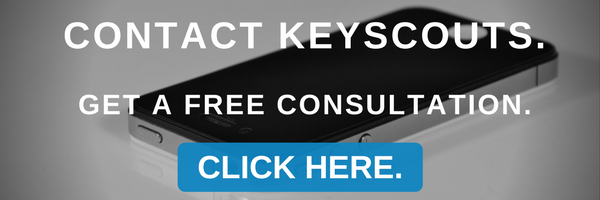
As the most popular social network for B2B content marketers, LinkedIn is robust, filled with half a billion regular users (read: prospects), and represents one of the best ways to connect with others and grow your personal network.
There’s a good reason content marketers love LinkedIn. Not only is it home to 9 million business profiles stretched across 200 countries, but the business-centric social platform is also fantastic for lead generation.
In fact, LinkedIn has been shown to generate more leads than blogging, posting on Facebook, or Tweeting, exhibiting some of the highest conversion rates of any other social media platform.
Still not convinced? Consider these facts:
- 64% of all visits to corporate websites originate on LinkedIn
- Around 15% of LinkedIn users don’t have a Facebook account
- Over half of LinkedIn users don’t visit Twitter

That makes LinkedIn a smart addition to your lead generation strategy. When it comes to marketing on the platform, the following checklist should help. Here is how to use the full capabilities of LinkedIn to generate qualified B2B leads.
1. Update Your Profile
With 65% of B2B leads coming from LinkedIn, you can’t afford to have a missing or outdated profile. Having an updated and fully comprehensive profile can help you better connect with prospects. Because the simple fact is, an incomplete profile looks unprofessional and can get you marked as a spammer if you start sending unsolicited messages asking to connect.
When you send an invitation to another user on LinkedIn, they view your profile in two different ways:
1. They see your photo, name, and title in their notification bar, which will also includes a small portion of your message.
After opening your message, the recipient will be able to accept or deny your message. For this reason, you’ll want to make sure your profile looks professional and inviting so that your prospects always choose to accept your message and connect.
Few people are going to rely on your name and title alone to gauge whether they should open your message or not. Your photo also matters a great deal. No, this isn’t a beauty or popularity contest, but people do want to know who they’re connecting with. You won’t get very far without a profile picture, in other words, and ideally you’ll go out and get a headshot taken so that you can make the very best first impression.
You can also take your photo with a good camera or smartphone while standing against a white wall, but you’ll get much better quality with a professional’s equipment and eye.
Your title should include your current job and any impressive titles that you hold, such as Marketing Executive or Chief Marketing Officer. You can get a great idea of how to craft an effective title by searching for others in your field, as well as the titles of those you’ll be connecting with.
2. They learn more about you by viewing your complete LinkedIn profile. In case your possible connections wish to go this route (and many will), you’ll want to have as complete a profile as possible.
A fully-stocked LinkedIn profile lends you legitimacy. It should list all your past employment positions along with everything you accomplished in those roles. Your summary should indicate that you are interested in connecting and should specify the types of people you’re most keen on meeting.
2. Identify & Segment Your Audience
You will have a better time and experience stronger lead generation results if you can manage to pinpoint your ideal client. This is otherwise referred to as a Buyer Persona.
Some companies go so far as to give their personas names and photos so that they can envision their perfect buyers more vividly. Your buyer persona should have, at the very least, the type of company he or she works for, its size and location, and the persona’s job title.
For best results, list the persona’s buying habits, interests, hobbies, pain points, and challenges. Check out this example from HubSpot:

The pain points are the very triggers you’re going to use to attract relevant B2B leads. The idea is to remind your prospects exactly why they would be interested in your business, products, and/or services. Done the right way, and if you can bring back those negative emotions with your messaging, you’ll soon have prospects begging you for help with the difficulties they face.
Once your buyer persona is established, start hunting for leads to connect with. You can use a tool like Get Prospect, which helps you find prospects on LinkedIn.

Or you could use the built-in LinkedIn Sales Navigator to find leads worthy of your invite.

Finding leads is the easy part. Segmenting those leads so that you can deliver targeted content based on their status and positions in your sales funnel is the part that takes a little more work.
You can segment your leads however you wish. Ensure that you are specific about your segmentation and that you understand what challenge each segment faces. You might separate your prospects by industry, title, region, or any other factor you wish, but segmenting is critical, so don’t leave this part out. You’ll find out why in a moment...
3. Harvest Leads & Engage
Once you know which leads you want to approach, start sending out connection requests. Never send the default message when sending invites. Instead, send a personalized message.
Call the person by name, explain who you are without boasting, and do your best to convey that you understand what the person does and what challenges they face.
Then tell them you’d like to reach out before providing a warm close like, “Thanks so much. I can’t wait to learn more about you.” A statement like that shows you care, and that you’re interested in much more than how many dollars they can contribute to your company’s bottom line.
4. Publish Content with Purpose
One of the primary reasons for segmenting your audience is so that you can deliver content that is specific and purposeful. For instance, two leads may share similar backgrounds, titles, and they may even work in the same industry, but the individuals could be at different stages in your marketing funnel.
One may be at the Awareness stage where they’re just now starting to research their pain points while the other may be “this close” to the Decision stage. Obviously, those individuals should get different marketing content tailored toward their needs.
Your job as a marketer is to discover what your prospects need and then deliver that content using a variety of channels, but most specifically the LinkedIn platform.
The great thing about LinkedIn is that you can post and share articles and other types of content, positioning you as an authority figure in your industry and establishing you as a trustworthy and valuable connection. Publish enough content, and you’ll have little trouble convincing new connections that you’re the real deal.
You are also encouraged to join LinkedIn groups or even start your own group. By giving out valuable advice on a consistent basis, you’ll solidify your position as a niche guru, and prospects may start approaching you with invitations to connect. Just make sure you stick to group policies while giving quality advice to those who need it most.
However, whether you are posting articles, sharing content, or commenting on group pages, make sure you are consistent. Keep a regular schedule so that your profile never looks dormant or out of commission. A schedule will show that you are reliable, and connections will know they can count on you for advice or excellent content in the coming weeks, months, and years.
5. Boost Lead Generation with LinkedIn Paid Ads
Another reason for segmenting your audience is so that you can target them with specific paid ads. When constructing your campaigns, ensure your ads speak to the problem the lead segment is facing, such as, “Need to generate more B2B leads?” Only people who are currently searching for B2B lead generation solutions will pay attention to that ad.
Use this knowledge to your advantage by pinpointing your segment’s problem and then delivering ads that promise a solution. “Need more leads for less?” your ads might read, and your prospects should be excited that, finally, someone is going to solve their most pressing issue.
Your ads can drive leads straight to your sales team, or you can promote a special event or an offering on your website. However, every campaign should have a specific goal before you put any ad spend in play.
Common goals might be to:
- Generate more leads
- Sell more SaaS subscriptions
- Increase revenues by a certain time.
These goals should be recorded somewhere so that they’re easy to remember, track, and so that you can analyze your results and optimize.
Here are a few more things you should keep in mind regarding paid ads on LinkedIn:
Set Your Advertising Budget
Each campaign will have a budget allotted that allows you to bid against competitors for higher ad placement on the LinkedIn platform. Until you know that your ads will perform well—that is after you’ve been able to test them and and analyze data—it’s recommended that you set your ad budget in the lower amounts. Then, once you see some leads coming in, feel free to boost your budget to extend visibility time and make your ads more noticeable.
Objectives & Segmentation
LinkedIn will make it easy to segment your leads so that you can deliver precision-targeted content to the right groups of prospects. Practice due diligence by researching which keywords to use, and use the advice already provided above to gather the necessary information to segment and target properly, such as company attributes, lead interests, titles, emails, and other important information.
Visual Ads
Ads with mere text can certainly perform well, provided the ad copy is on point and your list of prospects is properly segmented, but visual ads are even more engaging. LinkedIn recently added auto-play video ads to the mix, allowing you to capture lead attention in all new ways.

Monitor & Optimize Your Ads
Once sufficient data comes in, you’ll be able to determine which ads are performing and which are not. You can remove the ones that aren’t, but the better way is to tweak the ads slightly to see if the changes help. Sometimes, changing the background, image, vocabulary, color of the text, or other elements can make a massive difference.
All the research in the world can’t tell you what a few months of paid ad analytics can, so use that data to make your ads stronger over time.
For ads that are performing well, test them to see if you can get them to perform even better. Run the same ad, but alter one element slightly, such as changing the background or headline, and see which version outperforms. This A/B testing will yield even more crucial analytics data that can help to bolster your campaigns in the future.
Conclusion
As with any online marketing strategy, LinkedIn marketing will take time to increase your footprint so that you can succeed at driving more viable leads your way. With a dedicated schedule, a decked out profile, continuous updates, and plenty of attention towards growing and nurturing your leads list, you’ll soon see why LinkedIn is preferred by B2B marketers for lead generation.
The alternative, of course, is to hire the experts to do all the heavy lifting for you. KeyScouts can help with our LinkedIn Marketing Program.
Wouldn’t you love to gather more leads while you focus on what you do best? Leave the LinkedIn marketing to us. Get in touch to learn more.





